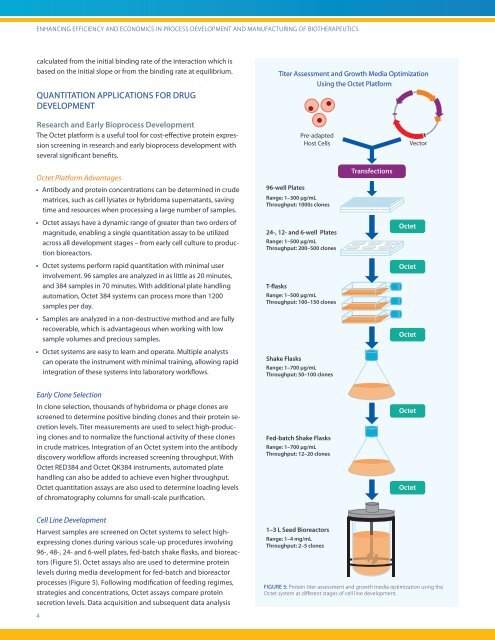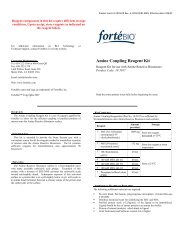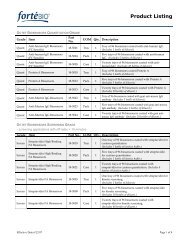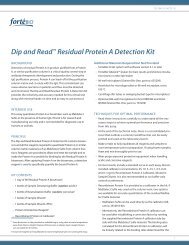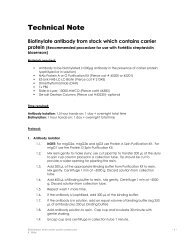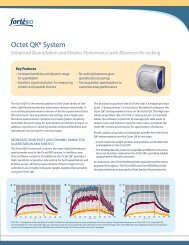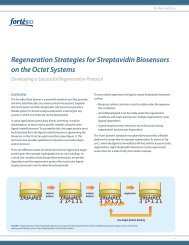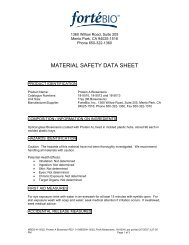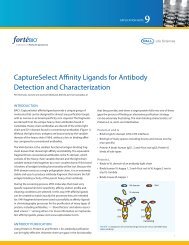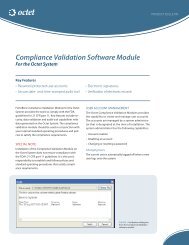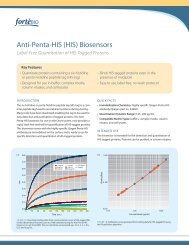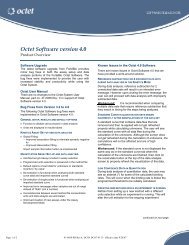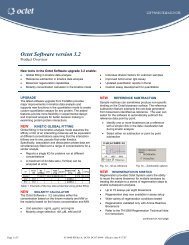Enhancing Efficiency and Economics in Process ... - ForteBio
Enhancing Efficiency and Economics in Process ... - ForteBio
Enhancing Efficiency and Economics in Process ... - ForteBio
Create successful ePaper yourself
Turn your PDF publications into a flip-book with our unique Google optimized e-Paper software.
<strong>Enhanc<strong>in</strong>g</strong> <strong>Efficiency</strong> <strong>and</strong> <strong>Economics</strong> <strong>in</strong> <strong>Process</strong> Development <strong>and</strong> Manufactur<strong>in</strong>g of Biotherapeutics<br />
calculated from the <strong>in</strong>itial b<strong>in</strong>d<strong>in</strong>g rate of the <strong>in</strong>teraction which is<br />
based on the <strong>in</strong>itial slope or from the b<strong>in</strong>d<strong>in</strong>g rate at equilibrium.<br />
QUANTITATION APPLICATIONS FOR DRUG<br />
DEVELOPMENT<br />
Titer Assessment <strong>and</strong> Growth Media Optimization<br />
Us<strong>in</strong>g the Octet Platform<br />
Research <strong>and</strong> Early Bioprocess Development<br />
The Octet platform is a useful tool for cost-effective prote<strong>in</strong> expression<br />
screen<strong>in</strong>g <strong>in</strong> research <strong>and</strong> early bioprocess development with<br />
several significant benefits.<br />
Octet Platform Advantages<br />
• Antibody <strong>and</strong> prote<strong>in</strong> concentrations can be determ<strong>in</strong>ed <strong>in</strong> crude<br />
matrices, such as cell lysates or hybridoma supernatants, sav<strong>in</strong>g<br />
time <strong>and</strong> resources when process<strong>in</strong>g a large number of samples.<br />
• Octet assays have a dynamic range of greater than two orders of<br />
magnitude, enabl<strong>in</strong>g a s<strong>in</strong>gle quantitation assay to be utilized<br />
across all development stages – from early cell culture to production<br />
bioreactors.<br />
• Octet systems perform rapid quantitation with m<strong>in</strong>imal user<br />
<strong>in</strong>volvement. 96 samples are analyzed <strong>in</strong> as little as 20 m<strong>in</strong>utes,<br />
<strong>and</strong> 384 samples <strong>in</strong> 70 m<strong>in</strong>utes. With additional plate h<strong>and</strong>l<strong>in</strong>g<br />
automation, Octet 384 systems can process more than 1200<br />
samples per day.<br />
• Samples are analyzed <strong>in</strong> a non-destructive method <strong>and</strong> are fully<br />
recoverable, which is advantageous when work<strong>in</strong>g with low<br />
sample volumes <strong>and</strong> precious samples.<br />
• Octet systems are easy to learn <strong>and</strong> operate. Multiple analysts<br />
can operate the <strong>in</strong>strument with m<strong>in</strong>imal tra<strong>in</strong><strong>in</strong>g, allow<strong>in</strong>g rapid<br />
<strong>in</strong>tegration of these systems <strong>in</strong>to laboratory workflows.<br />
96-well Plates<br />
Pre-adapted<br />
Host Cells<br />
Range: 1–300 µg/mL<br />
Throughput: 1000s clones<br />
24-, 12- <strong>and</strong> 6-well Plates<br />
Range: 1–500 µg/mL<br />
Throughput: 200–500 clones<br />
T-flasks<br />
Range: 1–500 µg/mL<br />
Throughput: 100–150 clones<br />
Shake Flasks<br />
Range: 1–700 µg/mL<br />
Throughput: 50–100 clones<br />
Transfections<br />
Vector<br />
Octet<br />
Octet<br />
Octet<br />
Early Clone Selection<br />
In clone selection, thous<strong>and</strong>s of hybridoma or phage clones are<br />
screened to determ<strong>in</strong>e positive b<strong>in</strong>d<strong>in</strong>g clones <strong>and</strong> their prote<strong>in</strong> secretion<br />
levels. Titer measurements are used to select high-produc<strong>in</strong>g<br />
clones <strong>and</strong> to normalize the functional activity of these clones<br />
<strong>in</strong> crude matrices. Integration of an Octet system <strong>in</strong>to the antibody<br />
discovery workflow affords <strong>in</strong>creased screen<strong>in</strong>g throughput. With<br />
Octet RED384 <strong>and</strong> Octet QK384 <strong>in</strong>struments, automated plate<br />
h<strong>and</strong>l<strong>in</strong>g can also be added to achieve even higher throughput.<br />
Octet quantitation assays are also used to determ<strong>in</strong>e load<strong>in</strong>g levels<br />
of chromatography columns for small-scale purification.<br />
Fed-batch Shake Flasks<br />
Range: 1–700 µg/mL<br />
Throughput: 12–20 clones<br />
Octet<br />
Octet<br />
Cell L<strong>in</strong>e Development<br />
Harvest samples are screened on Octet systems to select highexpress<strong>in</strong>g<br />
clones dur<strong>in</strong>g various scale-up procedures <strong>in</strong>volv<strong>in</strong>g<br />
96-, 48-, 24- <strong>and</strong> 6-well plates, fed-batch shake flasks, <strong>and</strong> bioreactors<br />
(Figure 5). Octet assays also are used to determ<strong>in</strong>e prote<strong>in</strong><br />
levels dur<strong>in</strong>g media development for fed-batch <strong>and</strong> bioreactor<br />
processes (Figure 5). Follow<strong>in</strong>g modification of feed<strong>in</strong>g regimes,<br />
strategies <strong>and</strong> concentrations, Octet assays compare prote<strong>in</strong><br />
secretion levels. Data acquisition <strong>and</strong> subsequent data analysis<br />
1–3 L Seed Bioreactors<br />
Range: 1–4 mg/mL<br />
Throughput: 2–5 clones<br />
Figure 5: Prote<strong>in</strong> titer assessment <strong>and</strong> growth media optimization us<strong>in</strong>g the<br />
Octet system at different stages of cell l<strong>in</strong>e development.<br />
4


